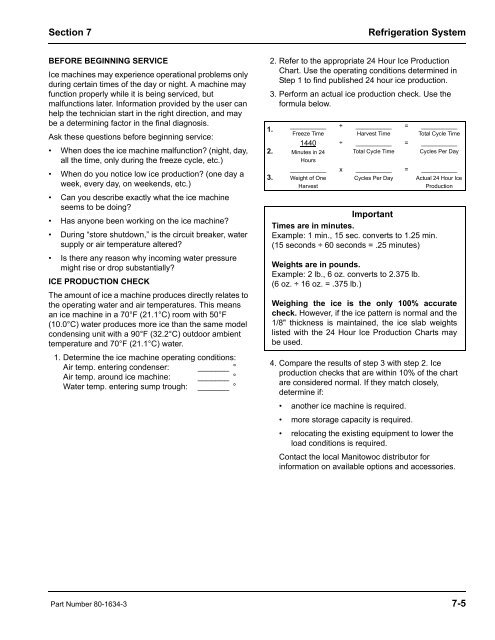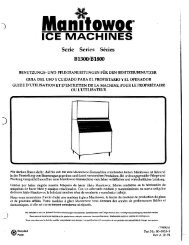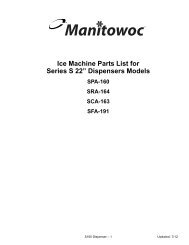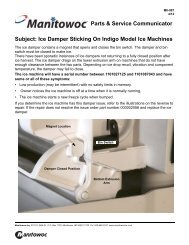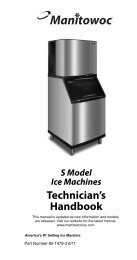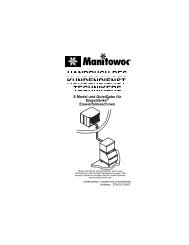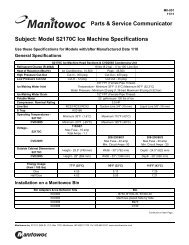S1800 Marine Model Ice Machines – Service Manual - Manitowoc Ice
S1800 Marine Model Ice Machines – Service Manual - Manitowoc Ice
S1800 Marine Model Ice Machines – Service Manual - Manitowoc Ice
Create successful ePaper yourself
Turn your PDF publications into a flip-book with our unique Google optimized e-Paper software.
Section 7 Refrigeration System<br />
BEFORE BEGINNING SERVICE<br />
<strong>Ice</strong> machines may experience operational problems only<br />
during certain times of the day or night. A machine may<br />
function properly while it is being serviced, but<br />
malfunctions later. Information provided by the user can<br />
help the technician start in the right direction, and may<br />
be a determining factor in the final diagnosis.<br />
Ask these questions before beginning service:<br />
• When does the ice machine malfunction? (night, day,<br />
all the time, only during the freeze cycle, etc.)<br />
• When do you notice low ice production? (one day a<br />
week, every day, on weekends, etc.)<br />
• Can you describe exactly what the ice machine<br />
seems to be doing?<br />
• Has anyone been working on the ice machine?<br />
• During “store shutdown,” is the circuit breaker, water<br />
supply or air temperature altered?<br />
• Is there any reason why incoming water pressure<br />
might rise or drop substantially?<br />
ICE PRODUCTION CHECK<br />
The amount of ice a machine produces directly relates to<br />
the operating water and air temperatures. This means<br />
an ice machine in a 70°F (21.1°C) room with 50°F<br />
(10.0°C) water produces more ice than the same model<br />
condensing unit with a 90°F (32.2°C) outdoor ambient<br />
temperature and 70°F (21.1°C) water.<br />
1. Determine the ice machine operating conditions:<br />
Air temp. entering condenser: _______ °<br />
Air temp. around ice machine: _______ °<br />
Water temp. entering sump trough: _______ °<br />
2. Refer to the appropriate 24 Hour <strong>Ice</strong> Production<br />
Chart. Use the operating conditions determined in<br />
Step 1 to find published 24 hour ice production.<br />
3. Perform an actual ice production check. Use the<br />
formula below.<br />
4. Compare the results of step 3 with step 2. <strong>Ice</strong><br />
production checks that are within 10% of the chart<br />
are considered normal. If they match closely,<br />
determine if:<br />
• another ice machine is required.<br />
• more storage capacity is required.<br />
• relocating the existing equipment to lower the<br />
load conditions is required.<br />
Contact the local <strong>Manitowoc</strong> distributor for<br />
information on available options and accessories.<br />
Part Number 80-1634-3 7-5<br />
1.<br />
2.<br />
3.<br />
__________<br />
Freeze Time<br />
1440<br />
Minutes in 24<br />
Hours<br />
__________<br />
Weight of One<br />
Harvest<br />
+ __________<br />
Harvest Time<br />
÷ __________<br />
Total Cycle Time<br />
x __________<br />
Cycles Per Day<br />
= __________<br />
Total Cycle Time<br />
= __________<br />
Cycles Per Day<br />
= __________<br />
Actual 24 Hour <strong>Ice</strong><br />
Production<br />
Important<br />
Times are in minutes.<br />
Example: 1 min., 15 sec. converts to 1.25 min.<br />
(15 seconds ÷ 60 seconds = .25 minutes)<br />
Weights are in pounds.<br />
Example: 2 lb., 6 oz. converts to 2.375 lb.<br />
(6 oz. ÷ 16 oz. = .375 lb.)<br />
Weighing the ice is the only 100% accurate<br />
check. However, if the ice pattern is normal and the<br />
1/8" thickness is maintained, the ice slab weights<br />
listed with the 24 Hour <strong>Ice</strong> Production Charts may<br />
be used.


